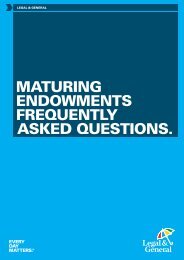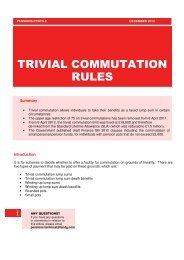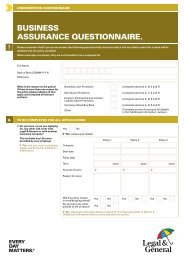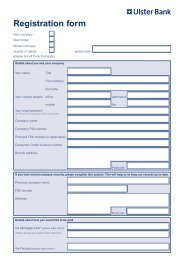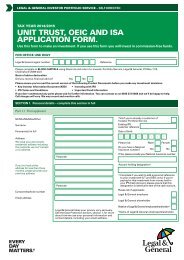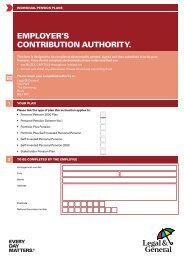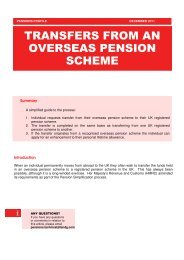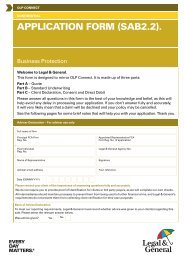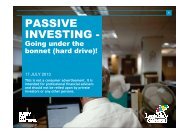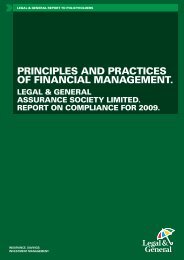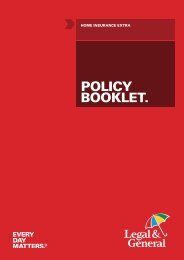INVESTMENT OPTIONS. - Legal & General
INVESTMENT OPTIONS. - Legal & General
INVESTMENT OPTIONS. - Legal & General
You also want an ePaper? Increase the reach of your titles
YUMPU automatically turns print PDFs into web optimized ePapers that Google loves.
Individual AND GROUP pensionS – Investment options<br />
3<br />
QUESTIONS AND ANSWERS.<br />
WHAT IS AN <strong>INVESTMENT</strong> FUND?<br />
When you invest in your pension plan you can put<br />
your money into one, or more investment funds.<br />
Each fund is divided into a number of units. Each<br />
time you make a payment into your plan we buy you<br />
some of these units in your chosen fund, or funds.<br />
Alternatively, rather than selecting your funds, you<br />
can invest in one of our Lifestyle Profiles which are<br />
explained on page 22.<br />
HOW IS MY <strong>INVESTMENT</strong> VALUED?<br />
For investments in our With Profits Fund<br />
• If you’re invested in our With Profits Fund, the<br />
value of your investment will normally grow<br />
when bonuses and any amounts we’ve previously<br />
committed to paying are added to your plan.<br />
Further details about how we value your With Profits<br />
investment are contained in our An introduction to<br />
Unitised With Profits guide which is available on<br />
request from your adviser.<br />
For investments in our unit-linked funds<br />
• If you’re interested in one of our unit-linked funds,<br />
it’s the unit price that determines how many units<br />
you buy and how much they’re worth when you<br />
sell them.<br />
Internal funds<br />
• Each day we calculate a unit price.<br />
• We use the general principle that if investments into<br />
the fund are greater than withdrawals, we need to<br />
buy assets. The unit price then takes account of the<br />
prices at which assets in the fund might be bought<br />
and the costs of purchasing those assets. Buying<br />
prices are generally higher than selling prices.<br />
• If withdrawals from the fund are greater than<br />
investments, we need to sell assets. The unit price<br />
then takes account of the prices at which assets<br />
might be sold for, together with the sale costs.<br />
Selling prices are generally lower than buying prices.<br />
• The difference between the values determined by<br />
each method of calculation is known as the ‘spread’.<br />
The amount of the spread usually depends upon<br />
the assets the fund invests in. The costs associated<br />
with buying or selling assets, such as stockbroker<br />
commissions, surveyor’s fees and stamp duty/taxes,<br />
will vary by asset type, country and company size.<br />
• The ‘spread’ is not a fixed amount and varies<br />
depending on market conditions, taxes<br />
and costs.<br />
• Funds that invest in commercial property, certain<br />
corporate bonds, smaller companies or emerging<br />
markets tend to have a larger dealing spread than,<br />
for example, funds such as the UK Equity<br />
Index Fund.<br />
• A significant change in the amount of money going<br />
into or out of the fund on a particular day may lead<br />
to a change in the method of calculation for that<br />
day’s valuation. This could result in a significant<br />
change in the unit price.<br />
The current spreads applicable to the unit-linked<br />
funds we manage are included in the Fund<br />
information section starting on page 8.<br />
Further details about how we value unit-linked funds<br />
and calculate unit prices are contained in our A guide<br />
to how we manage our unit-linked funds, which is<br />
available on request from your adviser.<br />
External funds<br />
• When calculating the unit price for our version of<br />
the fund, we use the price supplied by the external<br />
fund manager.<br />
Further details about managing and valuing external<br />
funds are contained in the Member’s Policy Booklet.<br />
WHAT ARE <strong>INVESTMENT</strong> ASSETS?<br />
Assets are what the funds invest in. They have<br />
a significant effect on the performance of your<br />
investment. It’s therefore important that you<br />
understand the differences between the main<br />
types of assets.<br />
There are four main types of asset and each has its<br />
own characteristics:<br />
• Equities<br />
• Fixed interest securities<br />
• Commercial property<br />
• Cash<br />
It’s generally a good idea to invest in a number of<br />
different assets within an asset type so that you do<br />
not rely on the performance of one individual asset.<br />
This strategy, called ‘diversification’, is basically what<br />
funds offer as they spread your investment across<br />
lots of assets.<br />
Many funds also invest in more than one type of<br />
asset to create even more diversification. Investing<br />
in a mix of funds is another good way to spread<br />
your investment.



